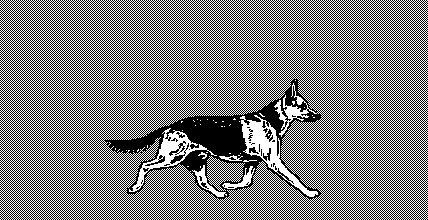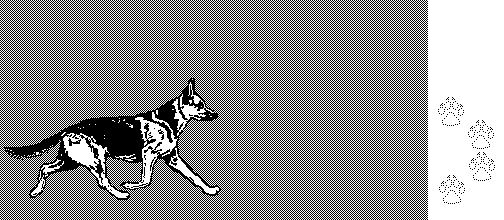A running
trot is shown in the above cartoon. The step sequence of the trot is shown at the right. The trot is a two-beat gait. Right and left diagonals alternate in supporting weight, i.e., the right forelimb and left hind limb move in unison as do left forelimb and right hind limb. The diagonal is named for the involved forelimb (right/left).
Actually, the hind limb of the diagonal impacts slightly earlier than the fore limb, though they appear to impact simultaneously. The hind limb provides both vertical and forward propulsion. The trunk is carried rigidly, undergoing only vertical oscillations, and the neck and head are fixed in an upright position during the trot.
In the
running trot (quick trot; brisk trot; flying trot) a suspension phase intervenes between each diagonal support phase (illustrated above and left). As the stride is lengthened in the running trot, interference can become a problem (the hind paw hits the ipsilateral forelimb). To avoid interference, the fore paw must be lifted before the ipsilateral hind paw arrives, or the hind paw must land to the side of the fore paw, or the animal must resort to crab-running (trunk at an angle to the line of progression).
In a
slow trot, the suspension phase is absent, so the body is always supported by one diagonal or the other. If the support phase is prolonged and the swing phase is shortened, three-limb support may intervene between the diagonal support phases.
The trot is a common gait in all domestic quadrupeds. It is well-suited for rough, irregular ground and for traveling long distances at a fair rate of speed. Work is spread evenly over all four limbs, and diagonal support makes it easy to maintain equilibrium. The trot is the natural foraging gait of most wild animals.
Relative to other quadrupeds, the dog exhibits a greater variety of trot variations (dog-trot; thrown trot; swung trot). In a "
dog-trot", the forelimb precedes the hindlimb at impact and lift. The German Shepherd typically exhibits suspension (
running trot; flying trot) when it trots. It's long body and low center of gravity of precludes interference and the need for compensatory crab-running. The
running trot is used by racing Standardbred horses. Interference is avoided by developing a long-bodied (long-coupled) horse, or the problem is minimized by using protective shoes.





